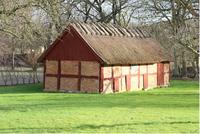Half-timber in Southern Sweden - history, transformation, construction and conservation
Short description
The project aims to build a profound knowledge base on half-timber in Southern Sweden and is focused on the history of built environments, craft, restoration, and the symbolic value of half-timber. The first stage of the project involves writing a bibliography and research overview to achieve a starting point for further research.
Background
Research on half-timber in Southern Sweden has not been documented since Carl Werner wrote his PhD thesis Half-timber in southern Sweden (Sydsvenskt korsvirke) in 1924. Without historical knowledge, we are not able to create an understanding of heritage.
Research aims
The project aims to build a profound knowledge base on half-timber i Southern Sweden. The research project is divided into different stages and is focused on the history of built environments, craft, restoration, and the symbolic value of half-timber. The first stage of the project involves writing a bibliography and research overview to achieve a starting point as well as shortcuts for further research. An important part of the project is to link the research to local studies, museum reports and work carried out by local historical associations, to create more shortcuts and comparative aspects, to see similarities and differences between towns such as Halmstad, Malmö, Kristianstad, and Ystad or between rural areas as the Albo and Luggude districts (”härader”). Too often such comparative perspectives have been neglected. Furthermore, it is important to highlight the half-timber heritage outside the old Danish heartland, to study the towns of Gamla and Nya Lödöse, Kalmar, and Visby, and notice the half-timbered buildings in Västergötland och Östergötland. Finally comes the international perspective with the outlooks to Denmark and Norway and the wider Northern European contexts.
The project is interdisciplinary and builds bridges between different relevant disciplines such as historical archaeology, ethnology, art history, cultural geography, conservation, and architecture. The project puts emphasis on linking research to local studies, museum reports and work carried out by local historical associations.
